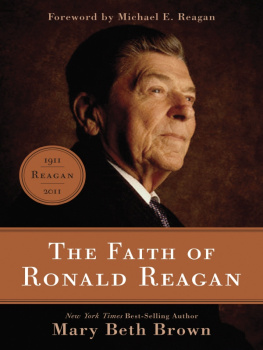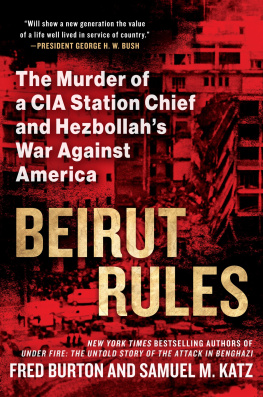The author and publisher have provided this e-book to you for your personal use only. You may not make this e-book publicly available in any way. Copyright infringement is against the law. If you believe the copy of this e-book you are reading infringes on the authors copyright, please notify the publisher at: us.macmillanusa.com/piracy.
When President Ronald Reagan agreed to support Israels invasion of Lebanon, he had neither the background nor the foresight to anticipate the river of blood that it would unleash. His disinterest in world affairs made him an easy mark for his unruly secretary of state, Alexander Haig; Israels obsessed prime minister, Menachem Begin; and its duplicitous minister of defense, Ariel Sharon. Their ambition was to use American military hardware and Israeli troops to change the map of the Mideast. They sucked the unwitting Reagan into a confrontation with ferocious and relentless opponents who conducted diplomacy with knives and bombs. It ended in defeat and blood-spattered humiliation for both Israel and the United States. Surrounded by conflict, ignorance, and incompetence in Washington, Reagan guided US foreign policy to a low point few presidents can match.
Alexander Haig sold Reagan on the Jerusalem governments ambitions primarily as a way to inflict a blow on the Soviet Unions most important client in the Mideast, Syria. In 1981, Reagan was on an anti-Moscow tear, undermining leftist governments in Latin America, Africa, and Afghanistan. He so terrorized the Kremlin that they actually feared Reagan was pushing World War III. Attacking Lebanon also meant attacking President Hafez al-Assad of Syria, who had 35,000 troops occupying Beirut and Lebanons Bekaa Valley and was contemplating annexing Lebanon. War with Syria was a certain result of Prime Minister Begins invasion of Israels northern neighbor. Along with Defense Minister Sharon, Begin was determined to finish off the Palestine Liberation Organization, which was encamped in southern Lebanon and West Beirut and also got help from Moscow. With Syria out of the way, Begin planned to install a pro-Jerusalem Christian warlord as president of Lebanon. At one point, Reagan secretly approved $10 million for Bashir Gemayel, Begins handpicked future leader of Lebanon. Israel would have a peace treaty with Lebanon in the north just as it did with Egypt in the south. In the end, however, Gemayel was assassinated and Israel withdrew, leaving Reagan as the rearguard in Beirut.
In some ways, Reagan was a victim of policies of his predecessors and events he understood vaguely if at all. Since the birth of Israel, US policy had supported it at almost every turn of wars with its Arab enemies in 1948, 1967, and 1973. American weapons were supplied to help defend the tiny Jewish nation. Jerusalems atomic bomb project at Dimonaunderwritten primarily by Francehad been quietly accepted by every American president since Dwight D. Eisenhower. A landmark in the arming of Israel came after Anwar el-Sadats surprise attack on Israeli troops during the Yom Kippur War of 1973. The Egyptian presidents forces ravaged Israeli armor and warplanes. President Richard Nixon resupplied the country with an astounding $2 billion in new warplanes, tanks, and munitions from American military stocks and factories. Later presidents, and even more often bipartisan US Congresses, gave Israel (as loans that were rarely repaid) squadrons of the worlds most advanced supersonic aircraftF-15 Eagles and F-16 Falconsand war-fighting electronics.
This multibillion-dollar American arsenal came with Defense and State Department restrictions: None of it could be used for aggressive purposes, only defense of Israel. Those prohibitions were effectively waived when Haig, a retired four-star general, gave Begin the green light for the invasion of Lebanon in 1981. When Israeli forces rolled into Lebanon in June of 1982, Americas most sophisticated weapons were used to destroy the Syrian air force. In two days, the Israelis piloted Eagles and Falcons and downed at least 86 Soviet-made warplanes. Statements by the White House, State Department, and Pentagon made clear Reagans support for what Israel called Operation Peace for Galilee. When Sharons attack stalled against Syrian troops in Lebanons Bekaa Valley, Israel shifted its focus to the PLO in West Beirut.
For 57 days, Israel pounded West Beirutthe Paris of the Mideastas horrified television viewers watched, The Arab world was outraged at the United States as well as Israel by the siege of West Beirut. More than ever before, Washington was backing Jerusalems ruthlessness. American warplanes flown by Israeli pilots destroyed scores of high-rise apartment buildings. Tanks surrounding the city, heavy artillery, and naval gunfire lit the night with explosions. Reagan and his State Department remained silent. It wasnt until Saudia Arabias King Fahd, brandishing another Arab oil embargo, demanded Reagan halt the siege that the American president intervened.
After the siege, turmoil and chaos in Beirut led Reagan to dispatch US Marines to command a multinational force to stabilize the city. The president was drawn deeper into mountain warfare between Muslims and Christians. When the Marines came under attack, Reagan became enmeshed in battlefield tactics as no other modern president had. He was given a Marine code nameSilver Screen Six. At one point, he telephoned from the Oval Office to the embattled commander in Beirut, Colonel Timothy Geraghty. Reagan finally ordered the reluctant Geraghty to attack Muslim forces with naval gunfire and warplanes from US ships in Beiruts harbor. Fearing retaliation on his badly exposed Marines, Geraghty refused the air strikes but did unleash naval gunfire.
For the next 19 years after the siege, the United States would suffer the consequences of Islams revenge. Osama bin Laden said the falling buildings in West Beirut in 1982 inspired his 2001 destruction of the World Trade Center. Even as the siege was under way, Irans leader, Ayatollah Ruhollah Khomeini, struck back. With permission from Syria, Tehran organized and financed a Shiite militia in Lebanons Bekaa Valley. Called Hezbollah, the Party of God, militant Muslims from Beirut followed Tehrans orders. Eight months after the siege, on direction from the ayatollahs, Hezbollah destroyed the US embassy in Beirut. Six months after that, they bombed the US Marine headquarters at Beirut International Airport. At the same time, they snatched from the streets American hostages that would continue Reagans Beirut nightmare for three more years. Reagans ransom of $50 million worth of US weapons for Iran failed to free the Americans. We were snookered, Secretary of State George Shultz told the president.
As a reporter for Newsday, I covered these events in Washington, Cairo, Jerusalem, and Beirut. Images of some of the 1,600 Palestinian bodies from the Sabra and Shatila massacre are still with me. An American body hanging from the Beirut embassy wreckage made me wince. The corpses of more than 3,000 mainly innocent Muslims killed during the siege littered the streets of West Beirut. Most painful, however, was watching the recovery of 241 US servicemen killed October 23, 1982. Heads, legs, arms, some whole torsos were scattered everywhere. A massive bomb reduced a 40-foot-tall concrete and steel building to a hole more than eight feet deep full of concrete slabs and moaning and dying Marines. I knew some of the dead from interviews. They had made me laugh with their comments and insights.












